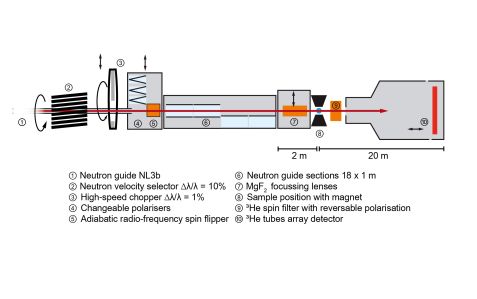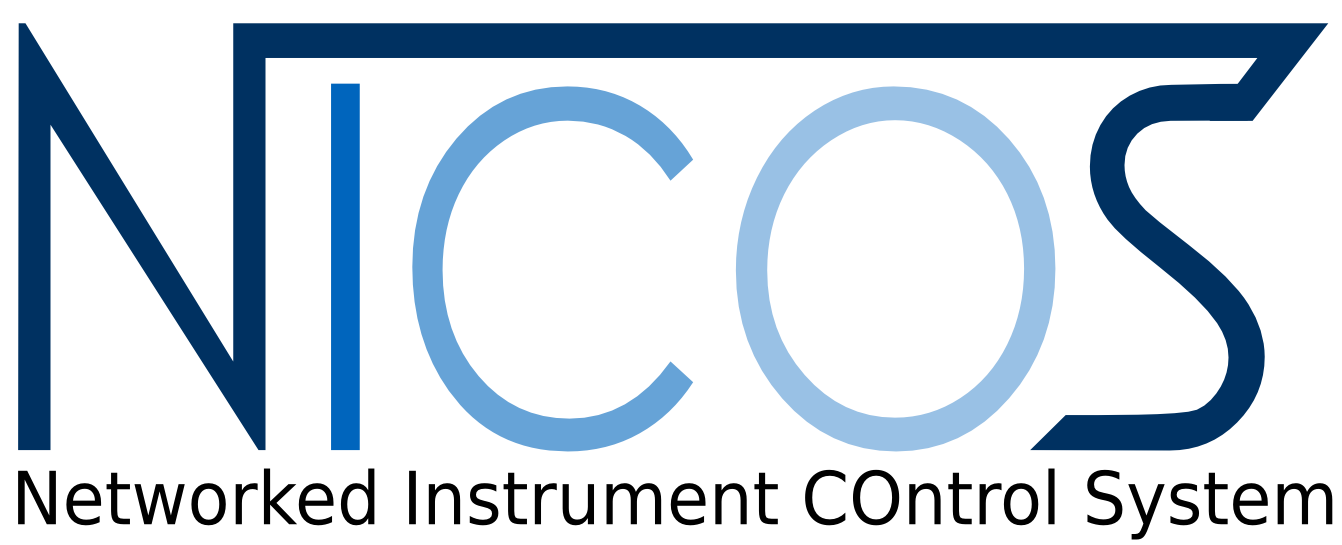MLZ is a cooperation between:
 > Technische Universität München
> Technische Universität München > Helmholtz-Zentrum Hereon
> Helmholtz-Zentrum Hereon
 > Forschungszentrum Jülich
> Forschungszentrum Jülich
MLZ is a member of:
 > LENS
> LENS > ERF-AISBL
> ERF-AISBL
MLZ on social media:

MLZ (eng)
Lichtenbergstr.1
85748 Garching
KWS-1
Small-angle neutron scattering (SANS) diffractometer

This instrument is focussed on cold neutrons. Therefore, please carefully check the “Technical data WITHOUT cold source” section. Deviating parameters are in bold. The instrument team is happy to answer any further questions!
KWS-1 is a small-angle scattering instrument with variable wavelength resolution dedicated to experiments with polarised neutrons and polarisation analysis [1].
A polariser with three cavities, each having a V-shaped supermirror, is placed in front of the collimation and covers the full wavelength band with min. 90 % (95 % typical) polarisation. A radio frequency spin flipper allows reverting the polarisation. The polarisation analysis is realised with an in-situ pumped 3He spin filter, which is optimised for the used wavelength and scattering angle. Horizontal and vertical magnets are provided to render the magnetic field at the sample position. The sample position of KWS-1 is equipped with a hexapod, capable of supporting up to half a ton of useful load enabling magnetic thin films to be investigated via grazing incidence small-angle neutron scattering (GISANS). The MgF2 lenses are used for the high flux mode with large sample areas, while the resolution stays in the classical SANS range.
For operation without the cold source, the instrument will be equipped with a 20 % tiltable wavelength selector to gain flux, enabling experiments on larger colloids and concentrated soft matter systems together with certain experiments on magnetic materials.
[1] Feoktystov, A. et al., J. Appl. Cryst. 48, 61 (2015).
- Grain boundaries
- Alloys
- Magnetic structures
- Flux lines
- Soft matter and biology (as for KWS-2)
- Complex fluids near surfaces
- Polymer films
- Magnetic films
- Nanoparticles
- Large colloids
- Concentrated soft matter systems
- Magnetic materials / nanoparticles
- Rheometer shear sandwich
- Rheowis-fluid rheometer: max. shear rate 104 s-1
- Anton-Paar fluid rheometer
- (Stopped-flow cell)
- Sample holders: 9 horizontal x 3 vertical (temperature controlled)
- Quartz cells
- Water thermostat: range 10 – 90 °C
- Electric thermostat: RT – 200 °C
- 8-positions thermostated (Peltier) sample holder: -40 – +150° C
- Magnet: horizontal, vertical
- Cryostat with sapphire windows
- High-temperature furnace
- Pressure cells: 500 bar, 2 kbar, 5 kbar
- Q = 0.003 – 0.5 Å-1
- Maximal flux: some 107 n cm-2 s-1
- Typical flux: some 106 n cm-2 s-1 (collimation 4 m, aperture 50 × 50 mm², λ = 3.5 Å)
- Dornier, tiltable, FWHM 20 %, λ = 3 Å – 12 Å
- 3-channel V-cavity, all wavelengths
- Polarisation at least 90 %, typical 95 %
- Radio-frequency (spin-flip probability better than 99.8 %)
- 2 m, 4 m, 8 m, 14 m, 20 m
- Rectangular 1 × 1 mm2 – 50 × 50 mm2
- Rectangular 1 × 1 mm2 – 30 × 30 mm2
- MgF2, diameter 50 mm, curvature 20 mm
- Three packs with 4, 6, and 16 lenses
- Hexapod, positioning precision better than 0.01 mm, 0.01°
- Detection range: 1.5 – 20 m
- 3He gas detector
- Efficiency better than 75 % (5 Å)
- Spatial resolution 8 × 8 mm2
- 1 m² active area
- Maximal counting rate 2 MHz (τ = 0.07 μs)
- Q = 0.0007 – 0.5 Å-1
- Maximal flux: 1.5 × 108 n cm-2 s-1
- Typical flux: 8 × 107 n cm-2 s-1 (collimation 4 m, aperture 50 × 50 mm², λ = 7 Å)
- Dornier, FWHM 10 %, λ = 4.5 Å – 20 Å
- 3-channel V-cavity, all wavelengths
- Polarisation at least 90 %, typical 95 %
- Radio-frequency (spin-flip probability better than 99.8 %)
- 3He spin filter with in-situ pumping
- 2 m, 4 m, 8 m, 14 m, 20 m
- Rectangular 1 × 1 mm2 – 50 × 50 mm2
- Rectangular 1 × 1 mm2 – 30 × 30 mm2
- MgF2, diameter 50 mm, curvature 20 mm
- Three packs with 4, 6, and 16 lenses
- Hexapod, positioning precision better than 0.01 mm, 0.01°
- Detection range: 1.5 – 20 m
- 3He gas detector
- Efficiency better than 75 % (5 Å)
- Spatial resolution 8 × 8 mm2
- 1 m² active area
- Maximal counting rate 2 MHz (τ = 0.07 μs)
Instrument scientists
Dr. Henrich Frielinghaus
Phone: +49 (0)89 158860-706
E-mail: h.frielinghaus@fz-juelich.de
Dr. Artem Feoktystov
Phone: +49 (0)89 158860-746
E-mail: a.feoktystov@fz-juelich.de
Dr. Zakaria Mahhouti
Phone: +49 (0)89 158860-805
E-mail: z.mahhouti@fz-juelich.de
KWS-1
Phone: +49 (0)89 158860-508
Operated by

Funding

Publications
Find the latest publications regarding KWS-1 in our publication database iMPULSE:
Citation templates for users
In all publications based on experiments on this instrument, you must provide some acknowledgements. To make your work easier, we have prepared all the necessary templates for you on this page.
Instrument control
Gallery




MLZ is a cooperation between:
 > Technische Universität München
> Technische Universität München > Helmholtz-Zentrum Hereon
> Helmholtz-Zentrum Hereon
 > Forschungszentrum Jülich
> Forschungszentrum Jülich
MLZ is a member of:
 > LENS
> LENS > ERF-AISBL
> ERF-AISBL
MLZ on social media:





